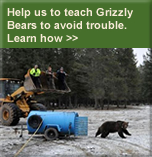
Overview
|
current status
Status of south Purcell and south Selkirk grizzly bears Grizzly bears used to occupy territory from northern Canada and Alaska all the way south into northern Mexico as recently as 100 years ago. Today their range has contracted throughout much of the US and portions of Canada (Figure 1). In the trans-border region the south Purcell and Selkirk populations are the southern extent of grizzly bears in the region (Figure 2). Bears at the edge of their distribution that has been limited by human activities face management challenges to resist further range contraction. Our goal is to insure these bears persist in their current range for future generations to enjoy and for the ecological integrity they provide. Bears in the trans-border south Selkirk and Purcell Mts. have been fragmented into sub-populations by human settled valleys and major highways (Link: Fragmentation & Linkage). Currently there are less than 100 grizzly bears in the South Selkirk ecosystem, and less than 50 in the S Purcell/Yahk subpopulation (Link: Kasworm et al 2009; Proctor et al. 2007a). The South Selkirk population is estimated to be increasing slightly, while the South Purcell/Yahk bears are decreasing (Link: Wakkinen and Kasworm 2004). Fragmented populations containing less than 100 bears have an increased conservation risk. Until very recently, the South Selkirk bears were completely isolated from neighboring bears, that is there was no inter-change or inter-breeding across the Creston Valley or Hwy 3A from Creston through Balfour to Nelson and Castlegar. This situation is a very serious conservation threat to these bears and establishing connectivity with adjacent sub-populations is a high priority of our work. The S Purcell/Yahk bears south of BC Hwy 3 are fragmented from bears to the east in the Rockies, to the west by the Creston Valley and BC Hwy 3A. Hwy 3 and the associated settlement appear to limit female movement. The low numbers of bears in this sub-population, the decreasing trend in population size, and the fragmentation described above puts the S Purcell/Yahk bears in a serious conservation category which requires enhanced management attention to reverse.  Fortunately, both of these sub-populations are immediately adjacent to a relatively healthy and large sub-population just to the north. Bears north of Hwy 3 in the Purcells are unfragmented all the way to BC Hwy 1 as are bears in the Selkirks north of Hwy 3A.The bears from both these mountain ranges are also seamlessly connected to each other north of Kootenay Lake and in total contain one of the region’s most important large core areas for grizzly bears in the southern Kootenay region. It is likely that over 600 grizzly bears inhabit this area and it is important for the long term future of the regional bears that this large area remain unfragmented. From a conservation biology perspective, this large core area of grizzly bears will help provide stability in for the whole region and potentially help bears apapt to climate change in the coming years. One of the main goals of the Trans-border Grizzly Bear Project is to re-establish interchange between the fragmented and threatened grizzly bears of the S Selkirk and S Purcell/Yahk with those in the Central Purcell Selkirk sub-population described above. The good news is that this goal is very achievable with well researched and targeted management. It is not enough to reconnect these populations, we need to also insure that human-caused mortality in the region is sustainable and there is suitable, sufficient, and secure habitat available for bears to persist within the S Selkirk and S Purcell/Yahk sub-populations. |
